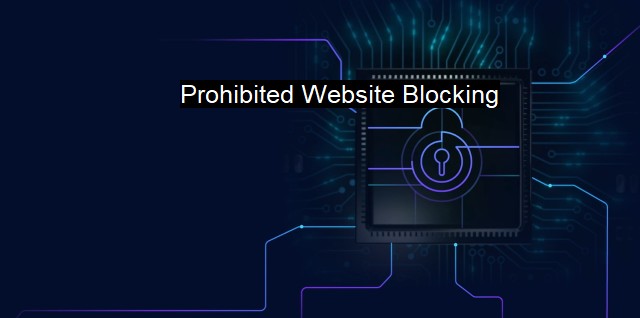What is Prohibited Website Blocking?
Prohibited Website Blocking in Cybersecurity: Enhancing Online Safety and Security by Blocking Harmful Internet Content
In the realm of cybersecurity and antivirus measures, "prohibited website blocking" refers to a range of methods or technologies that prevent access to specific websites. Usually, these websites contain potentially harmful content, adult content, or any other content subject to restrictions either by a legal jurisdiction, network administrator, or personal preferences of the users.Cybersecurity forms a crucial part of the digital world, especially given the proliferation of online cyber threats. One aspect to safeguard internet users is through the use of internet filters employing the concept of prohibited website blocking. This process is engineered to detect and thwart malicious content from presenting itself to the end-user or seeping into the host system's nucleus causing potential damage or risk.
This banning or blocking is typically achieved through software developed by cybersecurity or antivirus companies, which to a large extent works based on defined algorithms. Predominantly, they maintain a database of prohibited URLs or web domains that users should not access. When a user tries to get on one of these flagged sites, the blocking software activates and prevents the user from visiting the site.
The mandate for these blocked websites typically extends to sites flagged for containing malware, phishing threats, viruses, and all manner of cyber threats. They also encompass sites that promote illegal activities or propagate hate speech, violence, and distribution of unconsented explicit content. Quite frequently, these prohibitions are supplemented by the category of behavior-tracking websites or those perceived to invade personal privacy.
Apart from reducing the risk of encountering cyber threats, prohibited website blocking also has other utilities. In the educational segment, schools may employ website blocking tools to regulate student online activities, limiting their access to educational content only. Similarly, workplaces also are known to block specific sites preventing employees from engaging with such content during work hours.
While blocking access to harmful web content significantly mitigates risk, it is not without criticism. Proponents of net neutrality and freedom of information argue that prohibited website blocking infringes upon personal freedoms and the provision of free access to information. From a technical perspective, there is always the question of the effectiveness of blocking software. Sophisticated cybercriminals have been known to change or mask their URLs to evade identification by even the most well-equipped antivirus programs. It means website blocking is not a foolproof solution and must be complemented by other cybersecurity measures.
It is noteworthy that prohibited website blocking remains a powerful tool in the cybersecurity fort. While the method is not full-proof as cyber threats grow in sophistication, it provides a sturdy first line of defense for many users, especially those who are not technologically inclined. It can potentially block harmful content while browsing, an often-underestimated functionality in our expanding digital presence. prohibited website blocking should not be the user's only line of defense, and comprehensive measures such as firewalls, antivirus software, regular software updates, and Internet security protocols should work in tandem to combat a vast panorama of cyber threats present on the web.

Prohibited Website Blocking FAQs
What is Prohibited Website Blocking?
Prohibited website blocking is a system implemented by cybersecurity and antivirus programs to block access to websites that are considered dangerous or a threat to user security. It is a preventive measure taken to protect users from accessing malicious content or phishing scams.Why do I need to have Prohibited Website Blocking enabled?
Enabling prohibited website blocking is an effective way to protect yourself from online threats. Many malicious websites are designed to steal sensitive information, such as credit card details and login credentials, and can cause extensive damage to your computer and online accounts. Prohibited website blocking is a proactive way to keep your sensitive information safe and secure.Can I override the Prohibited Website Blocking feature?
In most cases, yes, you can override the prohibited website blocking feature. However, we strongly advise against it. The websites that are blocked have been determined to be unsafe or potentially harmful, and attempting to access them can lead to serious consequences. If you believe that a website has been incorrectly blocked, contact your antivirus provider or IT department for assistance.What happens if a Prohibited Website is accidentally accessed?
If you accidentally access a prohibited website, you may be putting your computer and personal information at risk. Malicious websites are designed to infect your computer with malware, steal personal information, or launch phishing scams. If you suspect that you may have accessed a prohibited website by mistake, immediately run a virus scan on your computer and change your login credentials for any online accounts that may have been compromised.| | A | | | B | | | C | | | D | | | E | | | F | | | G | | | H | | | I | | | J | | | K | | | L | | | M | |
| | N | | | O | | | P | | | Q | | | R | | | S | | | T | | | U | | | V | | | W | | | X | | | Y | | | Z | |
| | 1 | | | 2 | | | 3 | | | 4 | | | 7 | | | 8 | | |||||||